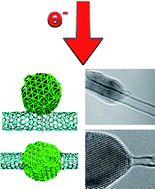Defect-induced junctions between single- or double-wall carbon nanotubes and metal crystals†
Abstract
Interfaces between the ends of single- or double-wall

* Corresponding authors
a
Institut de Physique et Chimie des Matériaux, UMR 7504 CNRS, Université de Strasbourg, France
E-mail:
Banhart@ipcms.u-strasbg.fr
b Materials Physics Division, University of Helsinki, P.O. Box 43, Finland
c Department of Applied Physics, Aalto University, P.O. Box 1100, Finland
Interfaces between the ends of single- or double-wall

 Please wait while we load your content...
Something went wrong. Try again?
Please wait while we load your content...
Something went wrong. Try again?
J. A. Rodríguez-Manzo, A. Tolvanen, A. V. Krasheninnikov, K. Nordlund, A. Demortière and F. Banhart, Nanoscale, 2010, 2, 901 DOI: 10.1039/C0NR00098A
To request permission to reproduce material from this article, please go to the Copyright Clearance Center request page.
If you are an author contributing to an RSC publication, you do not need to request permission provided correct acknowledgement is given.
If you are the author of this article, you do not need to request permission to reproduce figures and diagrams provided correct acknowledgement is given. If you want to reproduce the whole article in a third-party publication (excluding your thesis/dissertation for which permission is not required) please go to the Copyright Clearance Center request page.
Read more about how to correctly acknowledge RSC content.
 Fetching data from CrossRef.
Fetching data from CrossRef.
This may take some time to load.
Loading related content
